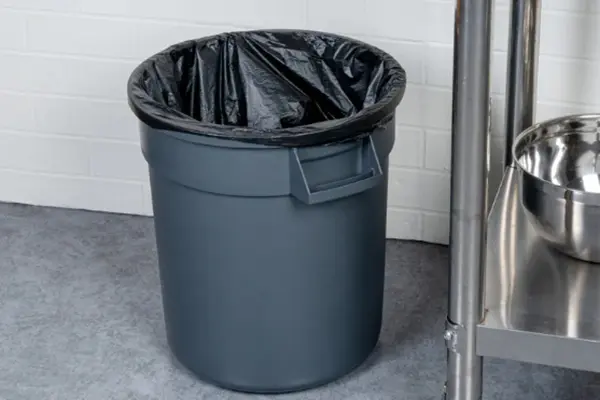Trash cans are essential in every household, office, and public space. They serve as a central hub for waste collection, helping to keep our environments clean and organized. But have you ever wondered what plastic is used to make these everyday items? Understanding the materials used for trash cans can give us a better sense of their durability, impact on the environment, and suitability for different uses.

1. High-Density Polyethylene (HDPE)
One of the most common plastics used in the production of trash cans is High-Density Polyethylene (HDPE). This durable plastic is known for its resistance to impacts, chemicals, and harsh weather conditions, making it ideal for outdoor waste bins. HDPE is widely used for both residential and commercial trash cans due to its strength and ability to withstand the wear and tear of daily use.
Why is HDPE Used?
- Durability: HDPE is incredibly tough and can resist cracking, puncturing, and warping even in extreme conditions.
- Weather Resistance: It is UV-resistant, meaning it won’t degrade or fade under prolonged exposure to the sun.
- Non-Toxic: HDPE is considered safe and non-toxic, making it a good choice for both household and industrial waste containers.
Example: Many curbside recycling bins and large commercial waste containers are made from HDPE due to their long-lasting nature.
2. Low-Density Polyethylene (LDPE)
Another common plastic used in trash can manufacturing is Low-Density Polyethylene (LDPE). While not as commonly used for the actual trash can structure, LDPE is often used for the production of trash can liners and bags. LDPE is known for its flexibility and resistance to moisture, which makes it ideal for holding waste that could leak or spill.
Why is LDPE Used?
- Flexibility: LDPE is more flexible than HDPE, allowing it to form trash bags that are easier to handle.
- Waterproofing: It is resistant to water, preventing liquids from seeping through trash bags.
- Low Cost: LDPE is relatively inexpensive to produce, making it a cost-effective choice for disposable liners.
Example: Trash bags, whether small kitchen bags or large industrial liners are usually made from LDPE.
3. Polypropylene (PP)
Polypropylene (PP) is another plastic material that is sometimes used for trash cans. It is known for its strength and durability, as well as its resistance to various chemicals and environmental factors. Polypropylene is less common in large outdoor trash cans but is sometimes used for smaller bins, office trash cans, and recycling containers.
Why is PP Used?
- Stiffness and Strength: Polypropylene offers a higher level of rigidity compared to LDPE, which helps ensure that smaller bins maintain their shape over time.
- Heat Resistance: PP has a higher melting point than many other plastics, making it suitable for use in environments where heat might be a concern.
- Recyclability: Polypropylene is fully recyclable, making it a more eco-friendly option compared to other plastics.
Example: Smaller indoor trash bins or office waste containers often use polypropylene.
4. Recycled Plastics
With increasing environmental concerns, many trash cans are now being made from recycled plastics. Recycled HDPE, for example, is frequently used for the production of new trash cans. The use of recycled materials helps reduce the overall environmental impact of waste management products and gives a second life to plastic materials that might otherwise end up in landfills.
Why is Recycled Plastic Used?
- Eco-Friendly: By repurposing used plastics, manufacturers reduce the demand for new raw materials and help cut down on plastic waste.
- Cost-Effective: Recycled plastics are often cheaper to source than virgin plastic, making it a more affordable option for manufacturers.
- Durability: Recycled HDPE retains much of the strength and durability of new HDPE, making it a practical choice for high-performance trash cans.
Example: Many curbside trash cans and recycling bins are made by companies with a focus on sustainability using recycled HDPE.
5. Polyethylene Terephthalate (PET)
Polyethylene Terephthalate (PET) is primarily used in the production of bottles and containers, but it is also sometimes used for lightweight, small trash bins. PET is known for being clear and strong, which makes it suitable for certain applications, though it’s not as common in larger trash cans due to its limited durability in high-impact situations.
Why is PET Used?
- Lightweight: PET is one of the lightest plastics, making it suitable for portable, small trash cans.
- Clarity: PET is transparent, which is beneficial for recycling bins or waste containers where users may want to see the contents.
- Recyclable: Like HDPE and PP, PET is recyclable, though it’s not typically as robust as other plastics in outdoor settings.
Example: Smaller, transparent waste containers used for paper or specific recycling items may be made from PET.
Conclusion
When it comes to trash cans, the plastic materials used vary based on the desired durability, flexibility, and intended use. HDPE is the most common material for outdoor trash bins due to its strength and resistance to environmental wear. LDPE is frequently used for trash bags, while PP is used for smaller, more rigid containers. The trend toward using recycled plastics is also growing, helping to reduce waste and promote sustainability. Understanding the types of plastics used in trash cans allows consumers to make more informed choices about their waste disposal needs, as well as about the environmental impact of their waste management products.
Ultimately, whether you’re buying a trash can for your home or a commercial setting, the plastic used plays a key role in determining the product’s durability, functionality, and eco-friendliness.
Post time: 02-14-2025



